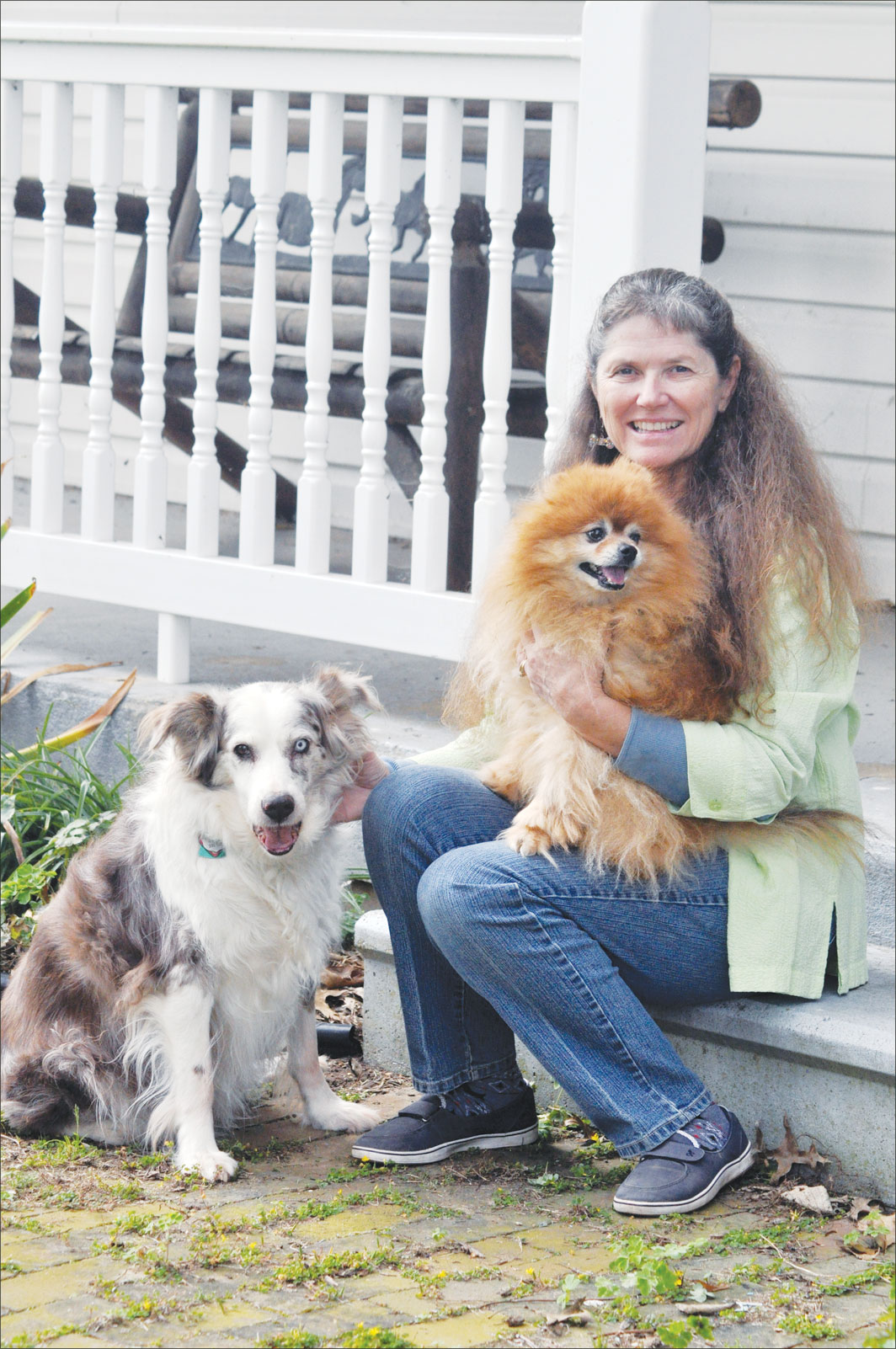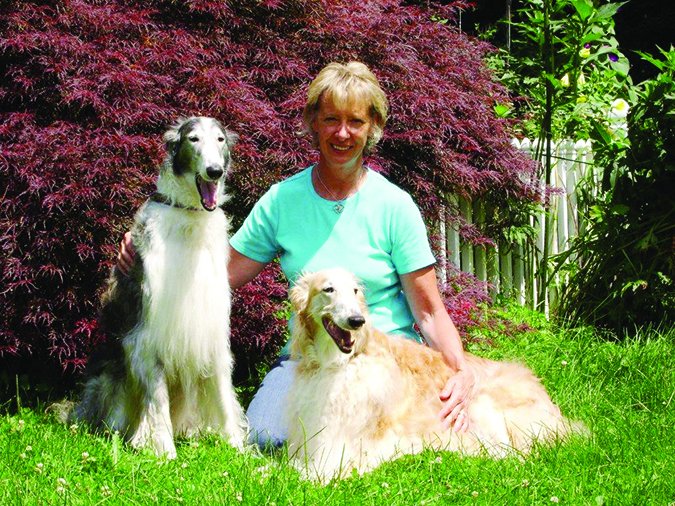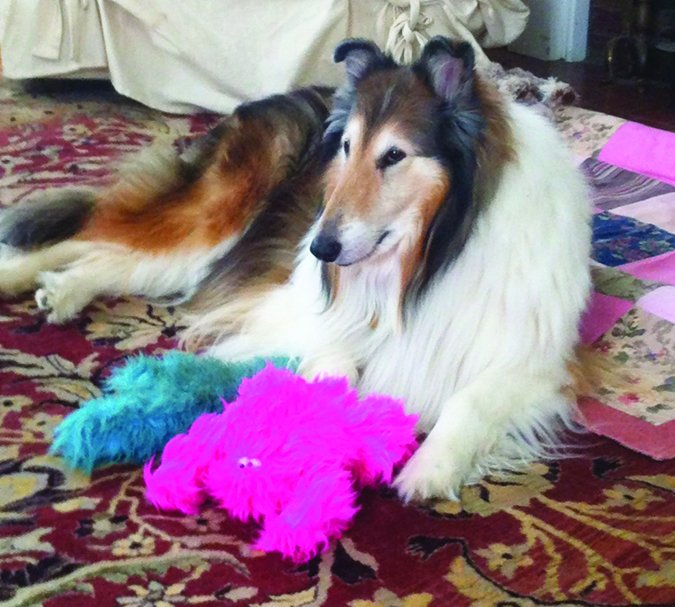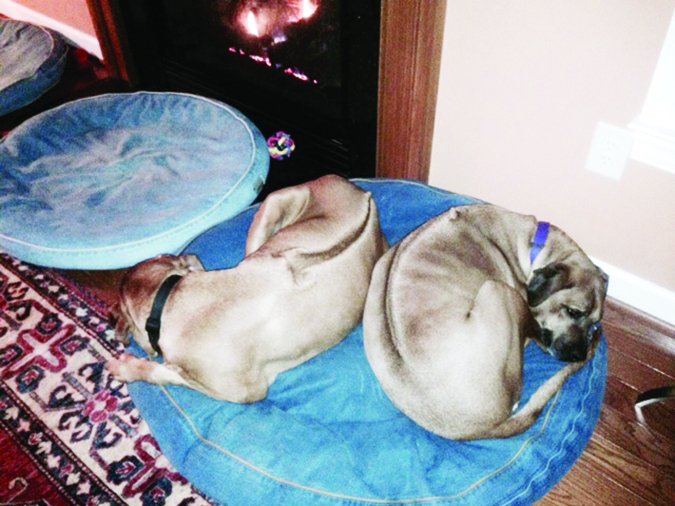[Updated August 24, 2018]
When my husband asked me to come to the shelter where he worked to meet the 8-year-old Australian Shepherd he had fallen in love with and wanted to adopt, of course I said yes. When Paul first met Missy, she threw herself on her back at his feet, and he was hooked. When I saw her striking red merle coat, her stunning “odd eyes” (one brown, one blue) and her delightful personality, I was smitten, too, and didn’t need any arm-twisting from my husband to agree to add this beautiful girl to our family. She slipped into her place in our home with barely a ripple, just as did Mandy, an 8-year-old tri-color Rough Collie and my first senior adoption, some 30 years prior.

If you are embarking on a senior adoption adventure, you’re likely to have many questions about your new old dog. What should you expect? How active will he be? How much management will he require? Should you plan to do any training with him? Will he need any training? If so, how much, what kind, and when? We asked several different trainers to share their wisdom on senior-dog adoptions.
Realistic Expectations
While adult-dog adoptions often go as smoothly as Mandy’s and Missy’s, they don’t always. There can be immense benefits inherent in adopting a dog who may already be housetrained and well beyond the puppy chewing and adolescent stages. However, because senior-dog adoptions aren’t always trouble-free, it’s safest to make no assumptions about your new adult canine family member.
Cindy Mauro, CPDT-KA, of Cindy Mauro Dog Training in West Milford, New Jersey, is very familiar with the rewards and challenges of older-dog adoptions.
“I have adopted many senior dogs. The last two were 13-plus years, and I’m expecting a senior girl to come to me in a couple weeks from a puppy-mill rescue,” she says.
“I keep in mind that training may require changing old habits, which requires patience. I never assume that the older dog is already trained, so instead of setting myself up for disappointment, I start off as I would any new dog – with a plan in place for training and management as soon as she comes in the door. I am pleasantly surprised and pleased any time things go easier than I thought they would.”
Absent solid information to the contrary, behave as though your new dog is not housetrained. He may have belonged to someone who forced him to soil indoors so he thinks carpeting is the appropriate substrate on which to eliminate, or maybe he spent the first eight years of his life with only shoes and sofa cushions for chew toys. Or, although he may be physically capable of “holding it” because he’s a mature adult, he’s lived outdoors all his life and never learned rules for indoor living.
Plan on implementing a senior-dog training and management plan that will set him up for success, by using an “every hour on the hour” puppy housetraining protocol. Also, practice diligent puppy-proofing – putting everything away that your new dog might view as a potential chew object. With a little luck he will quickly show you that your precautions are unnecessary and you can relax your standards. If, however, your precautions are justified, you will have set him up to succeed by not allowing him to be reinforced even one time for unwanted behaviors in his new environment. This will help him to learn new rules and appropriate new behaviors much more quickly.
My standard practice of keeping small Tupperware containers of treats in every room will serve you well with your senior adoptee, as will a never-ending supply of cookies in your pockets. You don’t want to miss a single opportunity to reinforce him for doing the right thing as the two of you create your relationship.
There’s No Hurry
This sort of proactive management will help you and your new dog get off on the right foot, but when it comes to actual training, it’s wise to take it slow with your senior adoptee, unless he makes it clear he’s ready for a fast track. Christine Danker, CPDT-KA, KPA-CTP, PMCT3, of Hemlock Hollow Dog Training in Albany, New York, offers these useful tips:
Give the older dog a quiet place to settle in for a few days. This should be located somewhere that enables her to see and/or hear everything going on in the house, or to retreat without disturbances if she prefers.

Plan on being home, or at least reduce your regular schedule considerably, so you can observe the new senior. Will she be afraid to be left in a room behind a baby gate? Will she be comfortable in a crate? Is she housetrained? Does she have hearing loss or mobility issues?
Slowly integrate the new senior into a house with other dogs. Was the new dog living alone? With other dogs? An active younger dog could be too rambunctious for a senior, but if their sizes are similar, the senior may really enjoy interacting with another dog.
Remember, a mature dog who lived for many years in one home can take longer to adjust to the sudden changes in his life than a younger dog might.
“Be mindful that a senior dog may have formed a strong bond with his former family,” says Dawn Kalinowksi, CPDT-KA, of Poised Pups, LLC, in Norfolk, Virginia. “Realize that he may even be mourning the loss of his beloved humans and the familiarity of his previous home. Don’t overwhelm him. It’s important to go slow and allow him time to bond with his new family and settle into this new environment.”
Susan Sarubin, PMCT-2, CPDT-KA, of Pawsitive Fit LLC, in Easton, Maryland, is in total agreement.
“Dogs who are re-homed later in life may need a more extended period of adjustment to a new home, given their longer history of behavior in their old home. Many older dogs come with additional fears and anxieties that extend beyond just normal adjusting to a new environment or new humans. For those dogs, the best way of dealing with this may be to just give the dog space, allowing him to choose where he wants to be, and when he wants to be with you and your family.
“Sometimes I think we’re in too much of a rush to teach older adopted dogs the behaviors we ultimately want them to learn to successfully assimilate into the family. Unless behavior is truly problematic and needs immediate attention, allow time for the dog to view you as predictable, safe, and the source of wonderful things (petting, treats, toys, walks, etc.). Teaching new behaviors will be easier to train once your new dog is less stressed and trusts you. Be patient, capture the behaviors you like, and forgo dedicated training sessions until your dog is happily interacting with you and appears calm and relaxed in his new home.”
Getting Along With Others
If you already have other four-legged family members, helping your new old dog adjust to his new home includes careful introductions and a management plan that protects your senior adoptee from the unwanted attentions of younger, more active dogs.
Here are some recommendations from Sharon Messersmith, owner of Canine Valley Training in Reading, Pennsylvania, who says, “If you are adding a senior dog into your household with younger dogs, specific training with all dogs will help with the transition.”

Teach all dogs to wait at steps to allow your older dog to go first, or vice versa.
Give each dog her own space and teach all your dogs to respect each others’ spaces.
An older dog might not be able to tolerate constant play all day. Give her a crate or room that is just for her when she needs some alone time.
Be Considerate of Physical Needs
Finally, keep in mind that your senior adoptee may have mobility issues that impact his daily routine in your home. Past injuries or simply age-related arthritis may dictate that you assist him with getting into vehicles, going upstairs, or even navigating the small raised threshold of a doorway. While Missy was able to climb our stairs to the second-floor bedroom for most of her time with us, for the last year of her life I routinely assisted her. In her final few weeks she slept downstairs, as it became too much of an ordeal to ask her to climb. Make sure water bowls and beds are easily accessible for your mobility-challenged new old dog, and consider installing ramps where possible to make life easier for the oldster.
Training an Old Dog
You may or may not need or want to (or have to) invest much energy into training your new old dog. Your own preference as well as your individual dog’s personality and abilities can guide you here. If you win the adoption lottery and your new family member is already housetrained and has decent manners (like Missy and Mandy), you can slide on the training.
You may also discover that your adoptee has some mobility issues that limit his physical capabilities. When I first met her, I noticed that Missy had a slight limp. When we had radiographs taken we found that her right hind leg was an inch shorter than her left due to a prior broken leg injury that hadn’t been properly treated. If we had ambitious goals for her, this might have been disappointing. As it was, since we only wanted her to be a happy farm dog, it wasn’t devastating – it only meant that we needed to watch for arthritis as she aged and alleviate her pain as needed.
Most trainers recommend taking a slow training approach with senior adoptees – slower than you might with a younger dog. Peaceable Paws trainer Laura Nalven, PMCT, shares an experience she had with a recent client:
“I’m reminded of someone in my classes who adopted a senior dog (probably 10 years old or so) just a week or so before class,” she relates. “She wanted to start training immediately because she remembered how much fun her previous (and much younger) dog had and how much it helped them bond.

“The old boy couldn’t see anything more than about eight inches from his face if it wasn’t moving, and his owner hadn’t realized this limitation in the short time they’d been together. Hearing or vision problems, coupled with general achiness, can make group classes full of bouncy adolescents an overwhelming experience. The class environment just stressed this dog out, and his owner felt like she wasn’t doing enough to bond with him.
“I’d suggest that you allow older dogs a longer period to adjust to their new home than you might a younger dog. If they’re peppy and eager to do training games, go for it. But if they’re laid back and just want to sit in the sun all day, let them.”
Clean Slate? Or Highly Experienced?
Nan Marks of Silver Spring, Maryland, is a Peaceable Paws Academy graduate who trains at Capital Dog Training Club in Silver Spring. She is also a veteran adopter of mature dogs. She shares her thoughts about training:
“This topic is near and dear to my heart. In recent years I have adopted a Rough Collie, Robbie, at age 8; a large bronze (Golden/Chow/Newfoundland?) mix, Bruce, at age 10; and most recently another 8-year-old Rough Collie, Lucy.
“All three were basically outdoor dogs; two of the three had been tied out their entire lives. These dogs have taught me two primary things: first, never assume that they won’t learn and enjoy learning just because they are older; and second, let their behavior, not their age, tell you what they are willing to try. All three became delightful companions, trained and active therapy dogs, two of the three learned some agility, and one competed and titled in obedience and canine freestyle.”
On one hand, your senior dog may come to you will little or no training, as did Marks’ dogs, described above. On the other, he may have had some training with the less-than-positive methods that are still all too common in the real world.
Peaceable Paws Academy graduate Jackie Moyano trains at WOOFS! in Arlington, Virginia, and Coventry School for Dogs in Columbia, Maryland, and also volunteers at the Animal Welfare League of Arlington, where she enjoys matching prospective adopters with appropriate senior dogs. She suggests having fun with your dog while introducing him to a new training relationship with humans based on mutual trust.
“While your mature dog may come to you knowing ‘sit’, ‘down,’ and ‘stay,’ you may not know the training methods used to teach these cues,” says Moyano. “Why not take a positive-reinforcement tricks class? Not only could this provide mental stimulation for your mature dog, it could accelerate your bonding!”
It Depends
So, the best answer to any question about a “new old dog” is . . . “It depends.” He may come to you already trained, or you may need to do a lot of management while you find out who he is and how you can best meet his needs. You may be able to jump right into a training program, or he may need time to settle in and take training at a slower pace. In any case, be prepared to fall every bit as deeply in love with your senior adoptee as you have with previous puppies and younger dogs who have been part of your family.
Just last year we said sad goodbyes to our beloved Missy when, at age 14, her injury-related arthritis finally dictated that we let her go. Although we were her humans for only six of her 14 years, it was as painful a loss as any we’ve experienced. When you adopt a new old dog, since you don’t have as much time to look forward to, you learn to treasure the years you do have with them.
Senior Successes
There is an endless supply of “new old dog” happy-ending stories like Missy’s and Mandy’s. Twelve-year-old Scooter is a beloved member of our family. We adopted the little Pomeranian five years ago when he was on the euthanasia list at our shelter after he failed his assessment due to his resource guarding (easily managed in our child-free home).

Trainer Susan Sarubin tells of her most recent adoption:
“The transformation in my 7 1/2-year-old adopted Rhodesian Ridgeback, Andy, has been quite remarkable since we adopted him over a year ago. There have been many ‘firsts’ in his behavior that have brought me tears of joy. Until recently, I spent little time with him that was dedicated to training – he experienced only the training that goes on with normal daily interaction, with rewards for desirable behavior. He has blossomed into the dog that he was never allowed to be in his previous life. We accomplished that in large part by letting him to come to it on his own. We have done 16 months of informal shaping, really. Now he learns behaviors on cue quickly – and most important, he’s a happy boy.”
Sometimes people worry that they won’t be able to bond with an older dog when they’ve missed out on the puppy and young-dog sharing experiences.
Trainer Nan Marks puts those fears to rest with these beautiful words:
“I remember early on fearing I would not love these older guys as much. Boy, was I wrong! For the most part I’ve found them easier to bond with quickly because they are more fully who they are already and not surfing the waves of puppyhood and adolescence.
“I also remember fearing that having only a short span to share with them would be too painful. I can only say that for the two who have now moved on, they were with me for three and four years, respectively, and those wonderful, loving years felt gloriously long to me in all the things that make having dogs meaningful.”
Pat Miller, CBCC-KA, CPDT-KA, is WDJ’s Training Editor. She lives in Fairplay, Maryland, site of her Peaceable Paws training center, where she offers dog-training classes and courses for trainers. Pat is also the author of many books on positive training. She has a terrific brand-new book, How to Foster Dogs: From Homeless to Homeward Bound.







Looking for an beagle ,older than a 6 mouth old